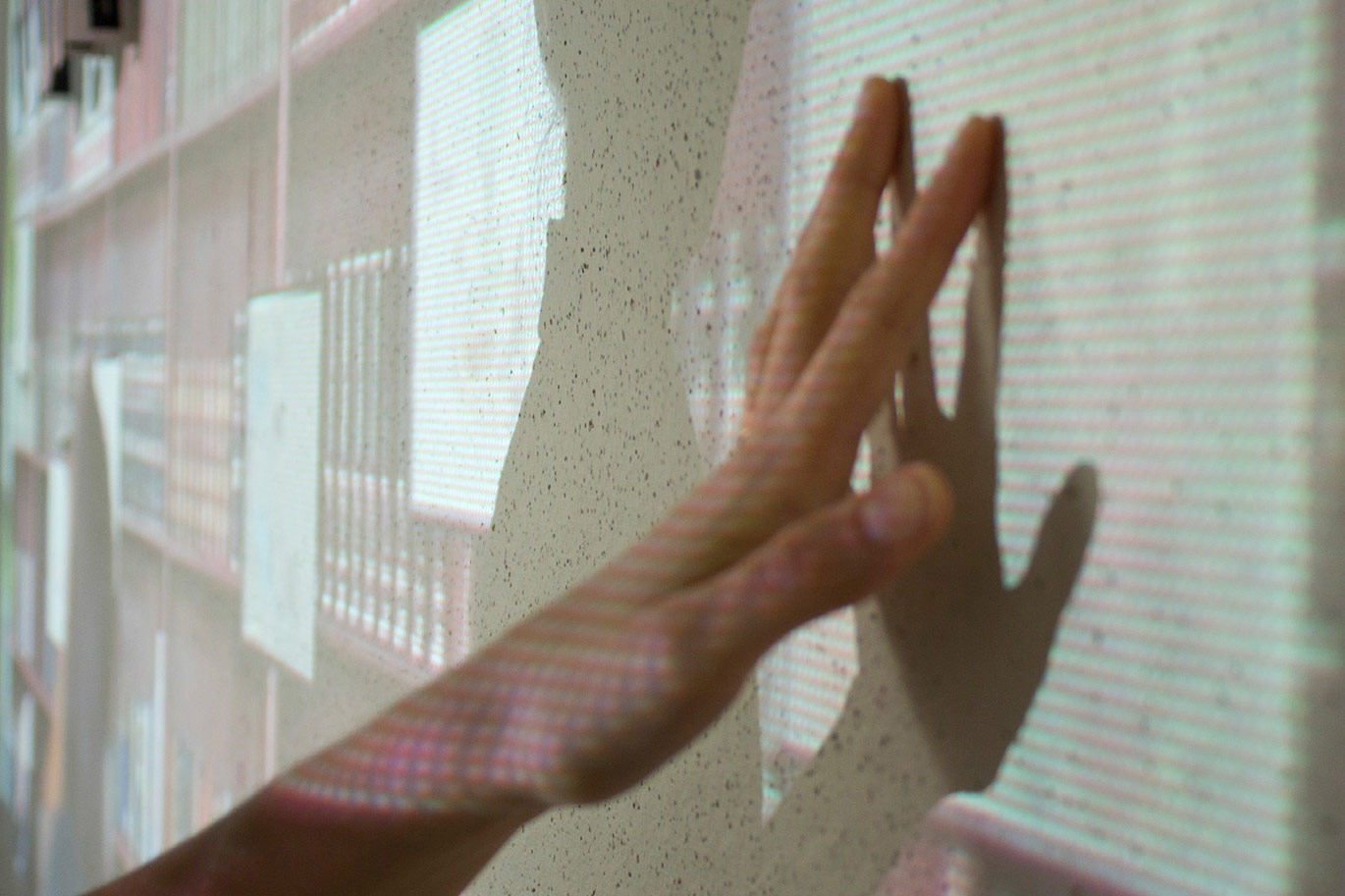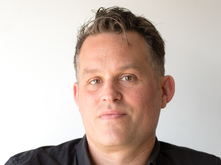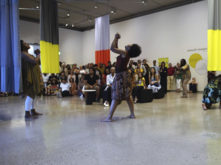Background
Noah Simblist is associate professor in the Painting + Printmaking department at Virginia Commonwealth University. He also works as a curator, writer, and artist with a focus on art and politics, specifically the ways in which contemporary artists address history. He earned his Ph.D in art history from the University of Texas at Austin (2015), his MFA in painting from the University of Washington (1999), and his BA in visual art from Hampshire College (1996).
Interview
What brought you to study Painting + Drawing at the University of Washington?
I went to Hampshire College and studied with Denzil Hurley for two years before he went to the UW in 1994. After I graduated I worked for an arts organization for a year and decided to go back to school for a MFA. I was a painter at the time and followed Denzil to the UW. He passed away this summer and I feel really fortunate to have been at his memorial that the UW organized this past November.
What are a few of your notable memories from your time as a student here?
I remember some great visiting artists like Robert Ryman, whom I ended up spending more time with in New York a few years later, and Louise Fishman, a terrific artist who lashed together feminism and a deep love of abstract painting and who unfortunately recently passed away. One particular memory that I have is of Vito Acconci’s lecture in which he described shifting from being a poet to an artist. He wrote concrete poems and the words started to move towards the margins of the page until they fell right off and into the world. I also spent a lot of time taking theory classes, I took a methods class with Alys Eve Weinbaum in the English department, a graduate seminar on feminism with Pat Failing, and a seminar on deconstruction with Marek Wieczorek. One notable graduate seminar was on Alexandre Kojève about his interpretation of Hegel that I took in the German department.
You have an MFA from the UW and 16 years later, received a PhD in Art History from the University of Texas, Austin. Would you be willing to share what led you down this path? Tell us about that transition?
It’s a long story but in many ways it starts with my time in Seattle. I was always an organizer and interested in ideas. I curated a show at SOIL when I was a member there and was a part of editing a zine called the Red Headed Step Child. Then later, when I moved to Texas, I started writing for Art Lies and Glasstire, which led to more national and international publishing and curatorial opportunities. My work as an artist had started to do something like what I described with Acconci. I was making paintings and drawings that had an abstract iconography that had to do with Jewishness and Israel-Palestine. I started making installations with wall text, video, and sound to contextualize the political and historical tensions that I was getting at in the paintings. Eventually the paintings fell away and so did the more conceptually based apparatus. I fell out of the frame of painting and into the world.
A turning point was in 2008, when I got a grant to make an artwork in Israel-Palestine about the Israeli Committee Against Housing Demolitions. They gathered international activists to rebuild Palestinian homes in the West Bank that have been destroyed by Israeli authorities. I wanted to make a video piece about this work but then I discovered that the Israeli artist Yael Bartana had done exactly that and shown it in Documenta 12! So I used the grant to write a feature on her work by participating in the camp for 2 weeks and reporting on that experience as a context to understand her piece Summer Camp. That moment was transformational for my practice and my politics. I went on to write a dissertation about the ways in which contemporary artists make work about the political implications of history in Israel-Palestine and Lebanon. Since then I have found it to be more creative but also more culturally productive to draw connections between things, to illuminate artworks by revealing their relationship to the world.
You work as a curator, writer, and artist and have an extensive and expansive CV. What accomplishments are you particularly proud of (and would you talk a little about them)?
My projects often include long term research and are almost always collaborative. For instance, Commonwealth explored how our common resources are used for the well-being of our communities. It was co-produced by three institutions in Virginia, Pennsylvania, and Puerto Rico and explored the historical concept of “commonwealth” and its legacy in each of the three locations. We acknowledged the collective power embedded in the term while recognizing its connection to colonialism. It started with a seminar that I taught at VCU, then went on to a public facing discursive space in the galleries, designed by an architecture firm based in Bogota. The ICA presented the main exhibition of the project because of the pandemic, and featured new commissions. Some highlights included works by Firelei Báez, Carolina Caycedo, Duron Chavis, Sharon Hayes, and Tanya Lukin Linklater. We produced an online publication and are currently working on a printed book.
New Cities, Future Ruins was a multi-year initiative that invited artists, designers, and thinkers to engage the extreme urbanism of America's Western Sun Belt, a space that stretches from Texas to California. Fast-growing symbols of opportunity and entrepreneurialism, the region’s cities, like Dallas or Phoenix, sprawl into delicate ecosystems. They’re marked by resource overuse, dramatic demographic change, and political struggle. These 21st-century spaces resist strategies inherited from post-industrial cities like Detroit or Pittsburgh and echo issues in global cities like Dubai, São Paulo, or Shenzhen. The project included multiple exhibitions, public art installations, lectures, panel discussions, and performances. Some highlights included performances by Postcommodity, Guillermo Gomez Pena, and Autumn Knight; video works by Sophia Al Maria and Cao Fei; and public artworks by lauren woods and Rodrigo Valenzuela.
What project(s)/initiatives/research are you currently working on?
I am currently working on the final stages of a book on Tania Bruguera’s The Francis Effect, a project that premiered at the Guggenheim Museum then traveled to LA and Dallas. The book will launch in May with an event at the ICA LA. I’m doing a residency just outside of LA this spring, where I’ll be working on 2 new book projects. I’m also currently working on an essay for March journal, co-written with Beatriz Balanta, a cultural critic based in Cali, Colombia. It’s about an aesthetic and ideological comparison of, what we’re calling, insurgent political theater, during the protests in Palestine and Colombia in May 2021. Finally, I’m in the early stages of another project at the Institute for Contemporary Art at VCU.
You’re Associate Professor and Chair of Painting + Printmaking at the Virginia Commonwealth University. As a leader in one of the top ranked art programs in the country, what are some of your thoughts about the future of teaching art in higher education?
I actually stepped down as chair in June of this past year and now focus on teaching and research full time. I have been in administrative positions for about 8 years and I think that the pandemic was a stress test that revealed something that many of us knew already. We are at a tipping point in the US, with a decline in population and, as a result, an applicant pool. We have to grapple with growing student debt, increased tuition, fewer full time faculty, more adjuncts and contingent faculty, the disinvestment of states from public education, and an increasingly neoliberal landscape in higher education that reflects the disaster capitalism of the broader economy. I think that educational institutions have a lot to learn from smaller informal schools around the world. I have been especially inspired by Ashkal Alwan in Beirut, SOMA in Mexico City, and Capacete in Rio de Janeiro.
What advice would you give to current or prospective students about the value of an arts degree?
I recently facilitated a roundtable of artists working in political activism and the artist and educator Anoka Faruqee made a great point about artists being excellent at knowing how to hustle with a DIY spirit, to make do with what we have available to create something meaningful for both yourself and your community. Artists, like organizers, also understand failure as being part of a process. Despite the challenges that I outlined above, I still am amazed by my students and their capacity to negotiate some of the most pressing issues of our day. Art school at its best is a space where we learn how to talk to one another about difficult things, to be both challenging and supportive, and to find a way to contribute something to culture at large. Whether art students remain artists or not, I think that these are invaluable skills to develop.
Links
Personal links:
Projects:
- Commonwealth exhibition
- Commonwealth summer sessions
- Commonwealth online publication
- New Cities, Future Ruins trailer
Recent reviews and features:
- Art-agenda | “The Dirty South: Contemporary Art, Material Culture, and the Sonic Impulse”
- Art in America | "Eye of the Storm: Allora & Calzadilla at the Menil Collection"
- Art in America | "Dread Scott's Struggle to Reclaim Collective Memory"
Recent interviews and roundtables:





